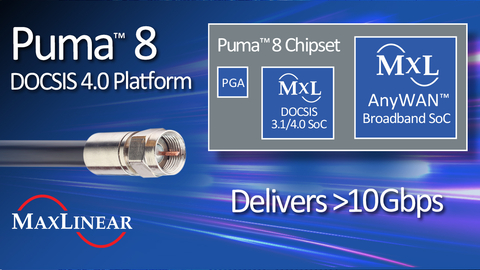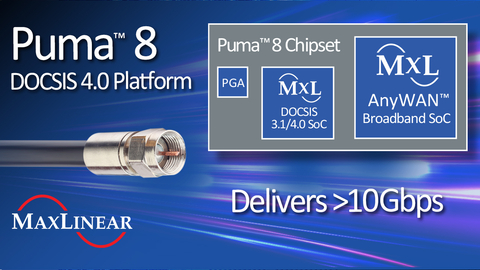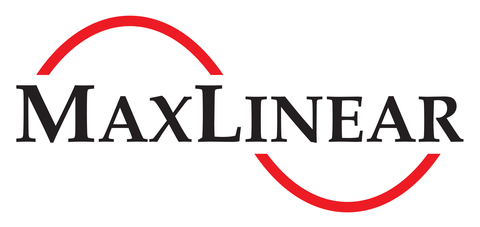CARLSBAD, Calif.--(BUSINESS WIRE)--MaxLinear, Inc. (Nasdaq: MXL) today announced that Puma 8, its ESD/FDD DOCSIS 4.0 cable modem and gateway platform, delivers greater than 10Gbps data throughput speeds as an Ultra DOCSIS 3.1 solution. With speeds close to PON fiber, Multi Service Operators (MSOs) now have a DOCSIS upgrade solution that requires minimal capital expenditure to achieve 10Gbps service over cable versus the cost of a full-scale DOCSIS 4.0 infrastructure overhaul. For service providers who want to upgrade to DOCSIS 4.0 immediately, Puma 8 can be coupled with MaxLinear’s single-chip, low-power DOCSIS 4.0 Ultra High Split (UHS) Upstream Programmable Gain Amplifier (PGA) that together can achieve upstream speeds of up to 7Gbps based on 6 x OFDMA channels in the 108MHz to 684MHz band and 1 x OFDMA channel on the legacy 5MHz to 85MHz band.
Designed to handle next-generation applications requiring ever more data speeds - such as gaming, digital health, and 8k streaming – the Puma 8 single-chip DOCSIS 4.0 solution meets the needs of MSOs who continually grapple with the decision of when and how best to upgrade broadband service for their customers. As MSOs balance customer expectations of faster and more reliable service versus revenue growth and operational efficiency, Puma 8 offers an extremely cost-effective solution of a seamless upgrade path to Ultra DOCSIS 3.1 and DOCSIS 4.0. As more costly broadband PON technologies become standard for some networks, Puma 8 provides MSOs with the financial flexibility to scale their cable-based versus PON-based data services strategically.
"MaxLinear’s new Puma 8 platform marks a significant leap forward in DOCSIS 4.0 technology," said Will Torgerson, VP/GM Broadband Group. "Our platform is designed for exceptional performance and energy efficiency, achieving over 10Gbps data speeds that rival fiber. This positions our MSO partners to deliver ultra-fast broadband with smart capital expenditure, elevating the home connectivity experience for consumers today and into the future."
Puma 8 presents significant cost advantage to MSOs, who are aiming to immediately provide customers with 10Gbps service via an Ultra DOCSIS 3.1 solution, with a cost-effective upgrade pathway to DOCSIS 4.0 in the future. By leveraging Puma 8 as an incremental upgrade to Ultra DOCSIS 3.1 within their existing traditional Hybrid Fiber-Coaxial (HFC) network, operators can significantly enhance their network data-speed performance without incurring the substantial costs associated with full-scale infrastructure overhauls required for full-duplex DOCSIS 4.0. This cost-efficient approach allows MSOs to tap into the benefits of advanced DOCSIS 4.0 technology, achieving enhanced data speeds and network capabilities, while strategically managing capital expenditure. This CAPEX control provides yet another layer of flexibility, minimizing and/or deferring the need for costly extensive network infrastructure modifications while navigating the evolving, multi-faceted landscape of providing high-speed broadband data services.
Ultra-High Split Upstream PGA
In addition to being optimized for cost, the Puma 8 platform is built for optimal performance. MaxLinear’s single-chip low-power DOCSIS 4.0 Ultra High Split (UHS) Upstream Programmable Gain Amplifier (PGA) was developed specifically to work and interface seamlessly with Puma 8, providing an unmatched end-to-end solution. Its low-power design, with minimal external discrete passive components, contributes to energy efficiency, small board footprint and reduced operational costs for OEMs and operators.
The DOCSIS 4.0 UHS PGA's ultra-high split upstream capability is pivotal for optimizing network performance as it enables a more efficient allocation of upstream frequency spectrum, facilitating increased upstream data capacity. This results in improved network responsiveness, reduced latency, and enhanced overall user experience, critical factors in meeting the growing demand for high-speed, low-latency connectivity.
Furthermore, the frequency tunable bandwidth of the PGA provides flexibility for network operators to adapt and optimize performance according to specific network bandwidth requirements. This adaptability ensures scalability and future-proofing, allowing operators to evolve and grow their network capacity in tandem with technological advancements without requiring extensive modem or gateway replacements.
MaxLinear's innovative Puma 8 based DOCSIS4.0 modem and gateway platforms, including its ultra-high split PGA, form the backbone MaxLinear’s optimized DOCSIS 4.0 broadband home access and connectivity ecosystem.
MaxLinear Puma 8 and PGA demos will be shown at CES 2024 in Las Vegas.
About MaxLinear, Inc.
MaxLinear, Inc. (Nasdaq: MXL) is a leading provider of radio frequency (RF), analog, digital, and mixed-signal integrated circuits for access and connectivity, wired and wireless infrastructure, and industrial and multimarket applications. MaxLinear is headquartered in Carlsbad, California. For more information, please visit https://www.maxlinear.com/.
MaxLinear, the MaxLinear logo, any other MaxLinear trademarks are all property of MaxLinear, Inc. or one of MaxLinear's subsidiaries in the U.S.A. and other countries. All rights reserved.
All third-party marks and logos are trademarks or registered trademarks of their respective holders/owners.
Cautionary Note About Forward-Looking Statements
This press release contains forward-looking statements within the meaning of Section 27A of the Securities Act of 1933, as amended, and Section 21E of the Securities Exchange Act of 1934, as amended. Forward-looking statements include, among others, statements concerning the anticipated growth in the potential market opportunities for the cable modem and gateway platform products and the functionality, performance and the benefits of use of Puma 8. These forward-looking statements involve known and unknown risks, uncertainties, and other factors that may cause actual results to be materially different from any future results expressed or implied by the forward-looking statements and our future financial performance and operating results forecasts generally. Forward-looking statements are based on management’s current, preliminary expectations and are subject to various risks and uncertainties. In particular, our future operating results are substantially dependent on our assumptions about market trends and conditions. Additional risks and uncertainties affecting our business, future operating results and financial condition include, without limitation; risks relating to our terminated merger with Silicon Motion and related arbitration and class action complaint and the risks related to potential payment of damages; the effect of intense and increasing competition; impacts of global economic conditions; the cyclical nature of the semiconductor industry; a significant variance in our operating results and impact on volatility in our stock price, and our ability to sustain our current level of revenue, which has declined, and/or manage future growth effectively, and the impact of excess inventory in the channel on our customers’ expected demand for certain of our products; the geopolitical and economic tensions among the countries in which we conduct business; increased tariffs, export controls or imposition of other trade barriers; our ability to obtain or retain government authorization to export certain of our products or technology; risks related to the loss of, or a significant reduction in orders from major customers; a decrease in the average selling prices of our products; failure to penetrate new applications and markets; development delays and consolidation trends in our industry; inability to make substantial research and development investments; any delays or expenses caused by undetected defects or bugs in our products; failure to attract and retain qualified personnel; failure to timely develop and introduce new or enhanced products; order and shipment uncertainties; failure to accurately predict our future revenue and appropriately budget expenses; lengthy and expensive customer qualification processes; customer product plan cancellations; failure to maintain compliance with government regulations; information technology failures; any adverse impact of rising interest rates on us, our customers, and our distributors and related demand; claims of intellectual property infringement; our ability to protect our intellectual property; and a failure to manage our relationships with, or negative impacts from, third parties.




